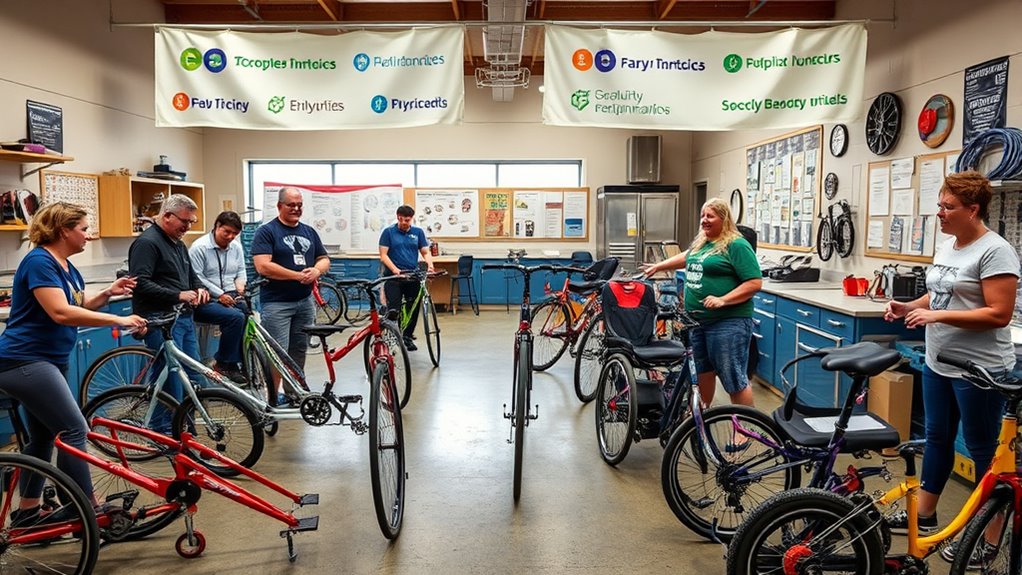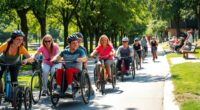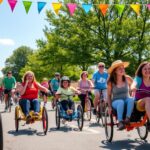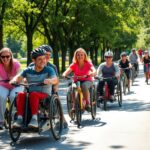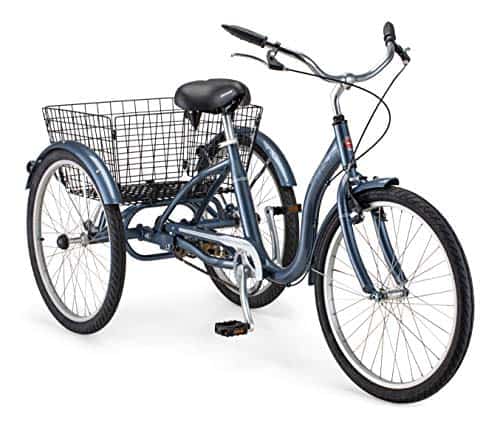Funding and grants for adaptive cycling equipment come from government programs, nonprofits, and community initiatives. You might qualify through health departments, Medicaid, or local support programs if you have a qualifying mobility impairment. Many grants cover bikes, accessories, and repairs but often require medical documentation and proof of need. Staying informed about eligibility and application steps can improve your chances. Keep exploring to discover more resources that can help you access the equipment you need.
Key Takeaways
- Multiple funding sources include government grants, nonprofit programs, and private foundations, each with specific eligibility criteria.
- Application processes typically require medical documentation, proof of financial need, and adherence to deadlines.
- Adaptive cycling equipment covered may include manual/power bikes, tricycles, accessories, and maintenance services.
- Insurance and Medicaid may cover adaptive bikes if medically necessary, often requiring HCPCS codes and physician approval.
- Specialized nonprofit grants, community programs, and crowdfunding can significantly increase access to adaptive cycling equipment.
Understanding Insurance and Government Coverage Options
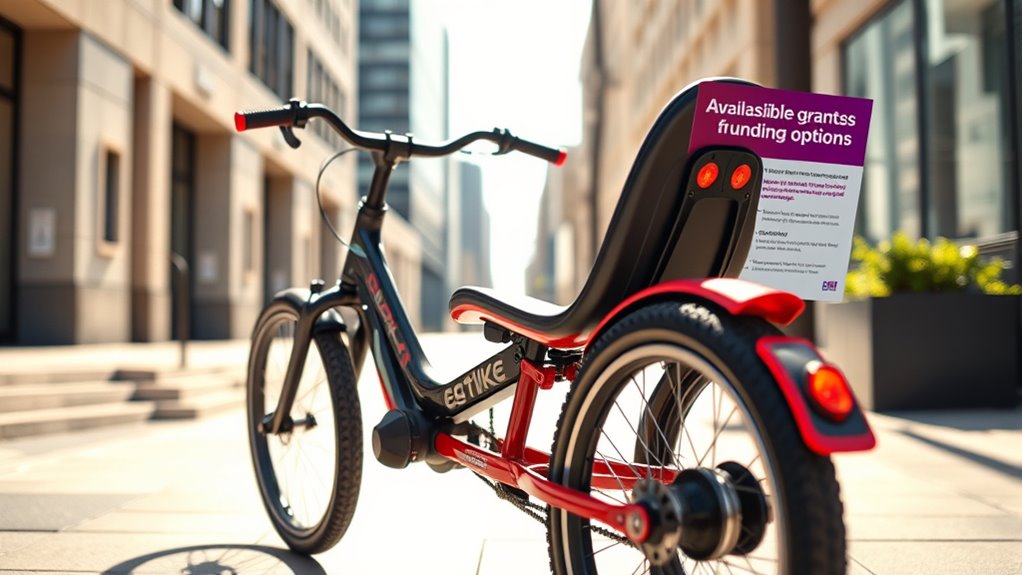
While insurance coverage for adaptive cycling equipment remains limited, understanding your options can improve your chances of obtaining funding. Most insurance plans rarely cover adaptive bikes, but higher-tier plans are more likely to provide coverage. You’ll often need to use HCPCS Code E1399 (DME Miscellaneous) and clearly justify medical necessity with your physician. Coverage usually applies only to basic models, excluding custom modifications. Additionally, staying informed about insurance policies and coverage options can help you navigate the complex process more effectively. Medicaid might cover adaptive bikes if deemed medically necessary, but each state has different rules and documentation requirements. A physician’s prescription is mandatory, and claims are processed under durable medical equipment. Being aware of coverage limitations can help you set realistic expectations and prepare necessary documentation. Staying updated on reimbursement policies can assist in strategizing your application process and increase the likelihood of approval. Keeping track of policy updates and changes in regulations can further enhance your chances of success. Be prepared for potential denials and appeals. Staying informed about evolving standards and maintaining thorough medical documentation can strengthen your case for coverage.
Nonprofit Grants Supporting Adaptive Cycling Equipment
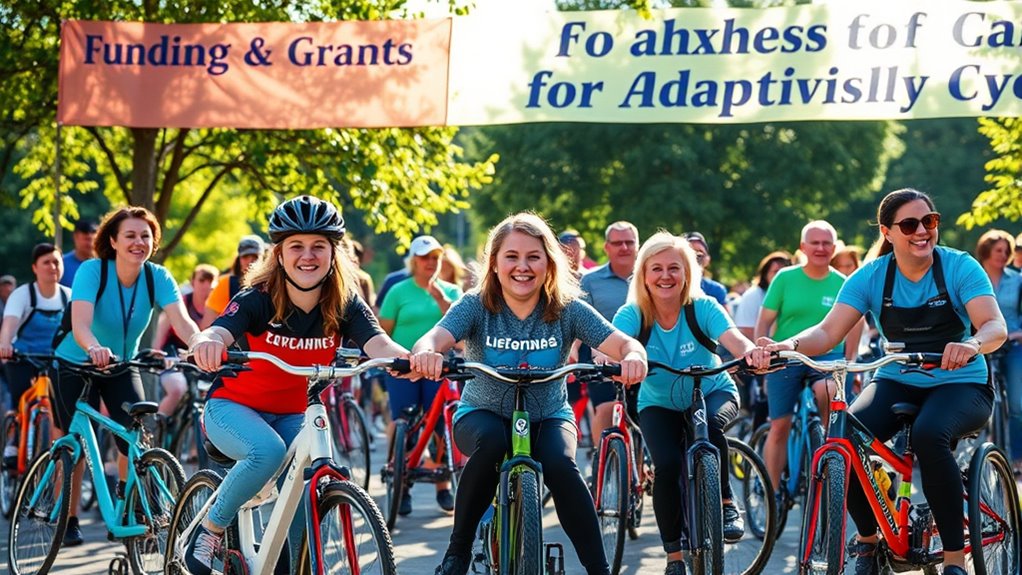
Nonprofit organizations play an essential role in expanding access to adaptive cycling equipment by offering various grants and support programs. The Kelly Brush Foundation Active Fund targets spinal cord injury patients, providing grants for adaptive sports gear. The Challenged Athletes Foundation supports adaptive sports and cycling equipment, while Semper Fi & America’s Fund focuses on military veterans and their families. Surfgimp Foundation helps with adventure equipment grants for individuals with disabilities, and Help Hope Live facilitates community fundraising for unmet equipment costs. To strengthen your application, document medical necessity and consider combining multiple funding sources. Understanding the importance of adaptive cycling equipment in promoting independence and mobility can also improve your chances of securing funding. Additionally, staying informed about emerging funding opportunities and advocacy efforts can increase your access to resources and support. Partner with organizations like RAD Innovations or Freedom Concepts, which connect applicants to grant opportunities. Building awareness of disability advocacy can also open doors to additional assistance and community support. These nonprofits are indispensable resources to make adaptive cycling equipment accessible and affordable, especially considering the expanding virtual collaboration opportunities that can facilitate partnerships and resource sharing.
Child-Focused Programs and Youth Grants

Child-focused programs and youth grants offer essential support to help children with disabilities access adaptive cycling equipment. Medicaid waivers like KidsWaivers.org list HCBS and TEFRA programs that may cover adaptive bikes when medically necessary. Some states’ waivers, such as California’s HCBS, fund adaptive bikes based on provider documentation. These programs often emphasize equitable access to mobility aids, helping to reduce disparities for children with disabilities. Age-specific grants, like those from the Challenged Athletes Foundation, prioritize youth with physical disabilities, offering funding for adaptive sports equipment. Early intervention programs in certain states include adaptive bikes as part of developmental therapy. Additionally, pediatric-specific funding sources, such as hospital partnerships and school district collaborations, help secure mobility aids. These programs focus on making adaptive cycling accessible, ensuring children receive the support they need for mobility, development, and independence. Online resources are available to guide families through the application process for these grants and programs. Understanding funding options can significantly improve the chances of obtaining necessary adaptive equipment. Recognizing the importance of funding eligibility criteria can further enhance the likelihood of success in grant applications.
Community Support, Crowdfunding, and Sponsorship Opportunities
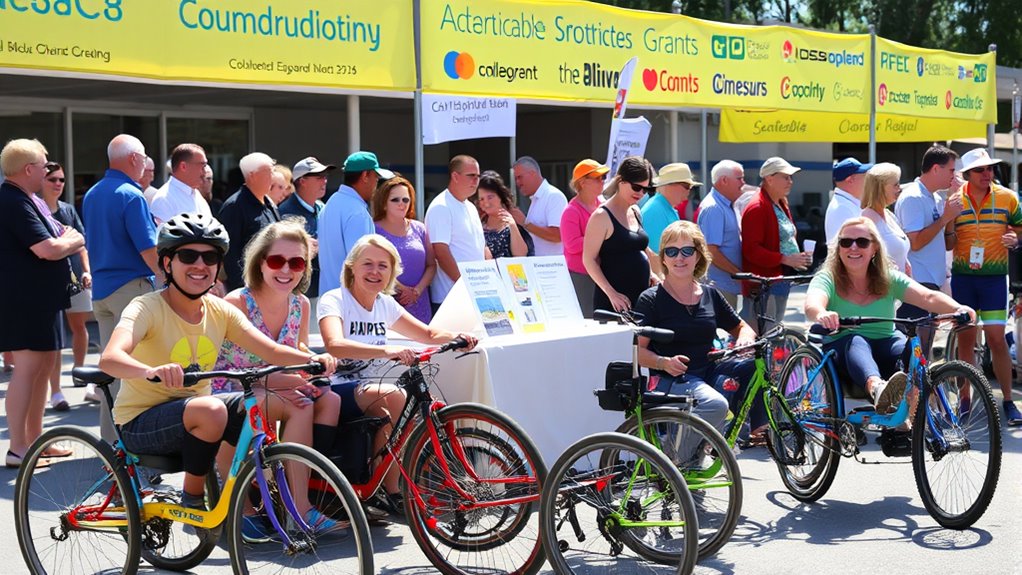
Community support plays a pivotal role in expanding access to adaptive cycling equipment, with local organizations, partnerships, and grassroots initiatives working together to break down financial and infrastructural barriers.
Community efforts are key to increasing access to adaptive cycling for all.
Wisconsin’s Kids Mobility Network utilizes CLTS Waiver and CCOP funding, collaborating with foundations to reduce out-of-pocket costs for families. Madison Adaptive Cycling advocates for inclusive infrastructure, while county agencies streamline equipment approval, assembly, and training through Kids Mobility’s full-service model.
Innovative funding strategies help sustain these programs and reach more individuals in need. Additionally, engaging with community partnerships can enhance resource sharing and advocacy efforts. Effective fundraising approaches are essential for maintaining and expanding support services.
Crowdfunding platforms like Help Hope Live and GoFundMe enable families to raise funds, especially when backed by detailed campaigns, healthcare endorsements, and social sharing. Building families’ confidence in navigating funding options can further empower their participation.
Moreover, understanding the accessibility features of adaptive equipment can improve purchasing decisions and ensure the equipment meets specific needs. Corporate sponsorships, such as the Freedom Concepts Dream Bike Program, connect nonprofits with local businesses for funding and environmental initiatives.
Together, these efforts empower communities to make adaptive cycling accessible and sustainable for all.
Specialized Resources for Spinal Cord Injury and Unique Needs

When seeking adaptive cycling solutions tailored to spinal cord injury and unique needs, understanding available specialized resources can make a significant difference.
Organizations like the Kelly Brush Foundation offer grants specifically for individuals with spinal cord injuries, often requiring residency in the US and medical documentation.
The IM ABLE Foundation provides hand-cycles and adaptive athletic gear, supporting active lifestyles.
The Motion Project Foundation focuses on rehab and adaptive equipment, including FES bikes and standers, to aid recovery and independence.
SCORE grants help individuals paralyzed during sports activities, potentially covering adaptive cycling gear.
Eligibility often depends on injury type, medical need, and application deadlines, such as September 18, 2024.
Knowing these resources helps you access tailored equipment that enhances mobility and quality of life.
Frequently Asked Questions
How Long Does It Typically Take to Receive Funding Approvals?
You’re curious about how long it takes to get funding approvals. Typically, it varies depending on the organization and application complexity.
If you submit a well-prepared application with all necessary documents, it can accelerate the process.
Expect at least a few weeks for review, but wait times can be longer if the competition is high or if additional information is needed.
Staying organized and prompt with your submissions helps guarantee a smoother approval timeline.
Are There Income Eligibility Requirements for Adaptive Cycling Grants?
You might wonder if income levels influence your chances of securing adaptive cycling grants. While some programs aim to support those facing financial challenges, many focus more on need’s overall picture, like disability or community impact.
Often, you’ll need to provide proof of income or disability, but eligibility varies widely. Your best bet is to research specific grants, as requirements can differ based on the organization and their priorities.
Can Multiple Funding Sources Be Combined for a Single Bike?
You can combine multiple funding sources for a single adaptive bike, but it’s not always straightforward. You’ll need to check each grant’s restrictions and eligibility criteria, as some may limit how funds are used or have maximum amounts.
Be prepared with detailed documentation to justify your needs, and understand that each application might have different timelines and approval processes.
Persistence and thorough research increase your chances of successfully combining funds.
What Documentation Is Needed to Apply for Government or Nonprofit Funding?
Oh, the joy of paperwork! When applying for government or nonprofit funding, you’ll need to gather quite a bundle. Start with your personal or organizational info.
Then a medical necessity letter from your healthcare provider. Don’t forget a detailed budget, a project outline, and proof of eligibility.
Support letters and community endorsements also help. Basically, it’s a treasure hunt of documents to prove your need and plan.
Are There Specific Age Restrictions for Certain Adaptive Cycling Programs?
You’re wondering if specific age restrictions apply to adaptive cycling programs. Many programs set age limits based on safety and skill requirements; for example, some offer clinics for children as young as 6, while others require riders to be at least 8 or 18.
Always check each program’s guidelines, as restrictions vary depending on the type of activity, equipment, and participant abilities to guarantee a suitable and safe experience.
Conclusion
So, after all this talk about grants and funding, you might think adaptive cycling equipment is just a click away. Ironically, steering the financial maze can be the biggest ride of your life. But don’t give up—your perfect adaptive cycle is closer than you think. With a little persistence, you’ll be pedaling beyond limits, proving that sometimes, the hardest obstacles are just opportunities in disguise. Keep going; the journey’s worth it.
